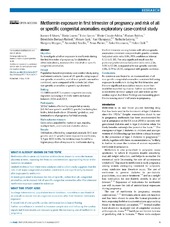| dc.contributor.author | Given, Joanne E. | en_US |
| dc.contributor.author | Loane, Maria | en_US |
| dc.contributor.author | Garne, Ester | en_US |
| dc.contributor.author | Addor, Marie-Claude | en_US |
| dc.contributor.author | Bakker, Marian | en_US |
| dc.contributor.author | Bertaut-Nativel, Bénédicte | en_US |
| dc.contributor.author | Gatt, Miriam | en_US |
| dc.contributor.author | Klungsøyr, Kari | en_US |
| dc.contributor.author | Lelong, Nathalie | en_US |
| dc.contributor.author | Morgan, Margery | en_US |
| dc.contributor.author | Neville, Amanda J | en_US |
| dc.contributor.author | Pierini, Anna | en_US |
| dc.contributor.author | Rissmann, Anke | en_US |
| dc.contributor.author | Dolk, Helen | en_US |
| dc.date.accessioned | 2019-04-16T13:09:38Z | |
| dc.date.available | 2019-04-16T13:09:38Z | |
| dc.date.issued | 2018 | |
| dc.Published | Given JE, Loane M, Garne E, Addor M, Bakker M, Bertaut-Nativel, Gatt M, Klungsøyr K, Lelong N, Morgan M, Neville AJ, Pierini A, Rissmann A, Dolk H. Metformin exposure in first trimester of pregnancy and risk of all or specific congenital anomalies: exploratory case-control study. BMJ (Clinical Research Edition). 2018;361:k2477 | eng |
| dc.identifier.issn | 0959-8138 | |
| dc.identifier.uri | https://hdl.handle.net/1956/19369 | |
| dc.description.abstract | Objective: To investigate whether exposure to metformin during the first trimester of pregnancy, for diabetes or other indications, increases the risk of all or specific congenital anomalies. Design: Population based exploratory case-control study using malformed controls. Cases of 29 specific subgroups of non-genetic anomalies, and all non-genetic anomalies combined, were compared with controls (all other non-genetic anomalies or genetic syndromes). Setting: 11 EUROmediCAT European congenital anomaly registries surveying 1 892 482 births in Europe between 2006 and 2013. Participants: 50 167 babies affected by congenital anomaly (41 242 non-genetic and 8925 genetic) including live births, fetal deaths from 20 weeks’ gestation, and terminations of pregnancy for fetal anomaly. Main outcome measure: Odds ratios adjusted for maternal age, registry, multiple birth, and maternal diabetes status. Results: 168 babies affected by congenital anomaly (141 non-genetic and 27 genetic) were exposed to metformin, 3.3 per 1000 births. No evidence was found for a higher proportion of exposure to metformin during the first trimester among babies with all non-genetic anomalies combined compared with genetic controls (adjusted odds ratio 0.84, 95% confidence interval 0.55 to 1.30). The only significant result was for pulmonary valve atresia (adjusted odds ratio 3.54, 1.05 to 12.00, compared with non-genetic controls; 2.86, 0.79 to 10.30, compared with genetic controls). Conclusions: No evidence was found for an increased risk of all non-genetic congenital anomalies combined following exposure to metformin during the first trimester, and the one significant association was no more than would be expected by chance. Further surveillance is needed to increase sample size and follow up the cardiac signal, but these findings are reassuring given the increasing use of metformin in pregnancy. | en_US |
| dc.language.iso | eng | eng |
| dc.publisher | BMJ | eng |
| dc.relation.uri | https://www.bmj.com/content/bmj/361/bmj.k2477.full.pdf | |
| dc.rights | Attribution CC BY | eng |
| dc.rights.uri | http://creativecommons.org/licenses/by/4.0 | eng |
| dc.title | Metformin exposure in first trimester of pregnancy and risk of all or specific congenital anomalies: exploratory case-control study | en_US |
| dc.type | Peer reviewed | |
| dc.type | Journal article | |
| dc.date.updated | 2018-08-03T10:53:49Z | |
| dc.description.version | publishedVersion | en_US |
| dc.rights.holder | Copyright 2018 The Authors | |
| dc.identifier.doi | https://doi.org/10.1136/bmj.k2477 | |
| dc.identifier.cristin | 1599621 | |
| dc.source.journal | BMJ (Clinical Research Edition) | |

